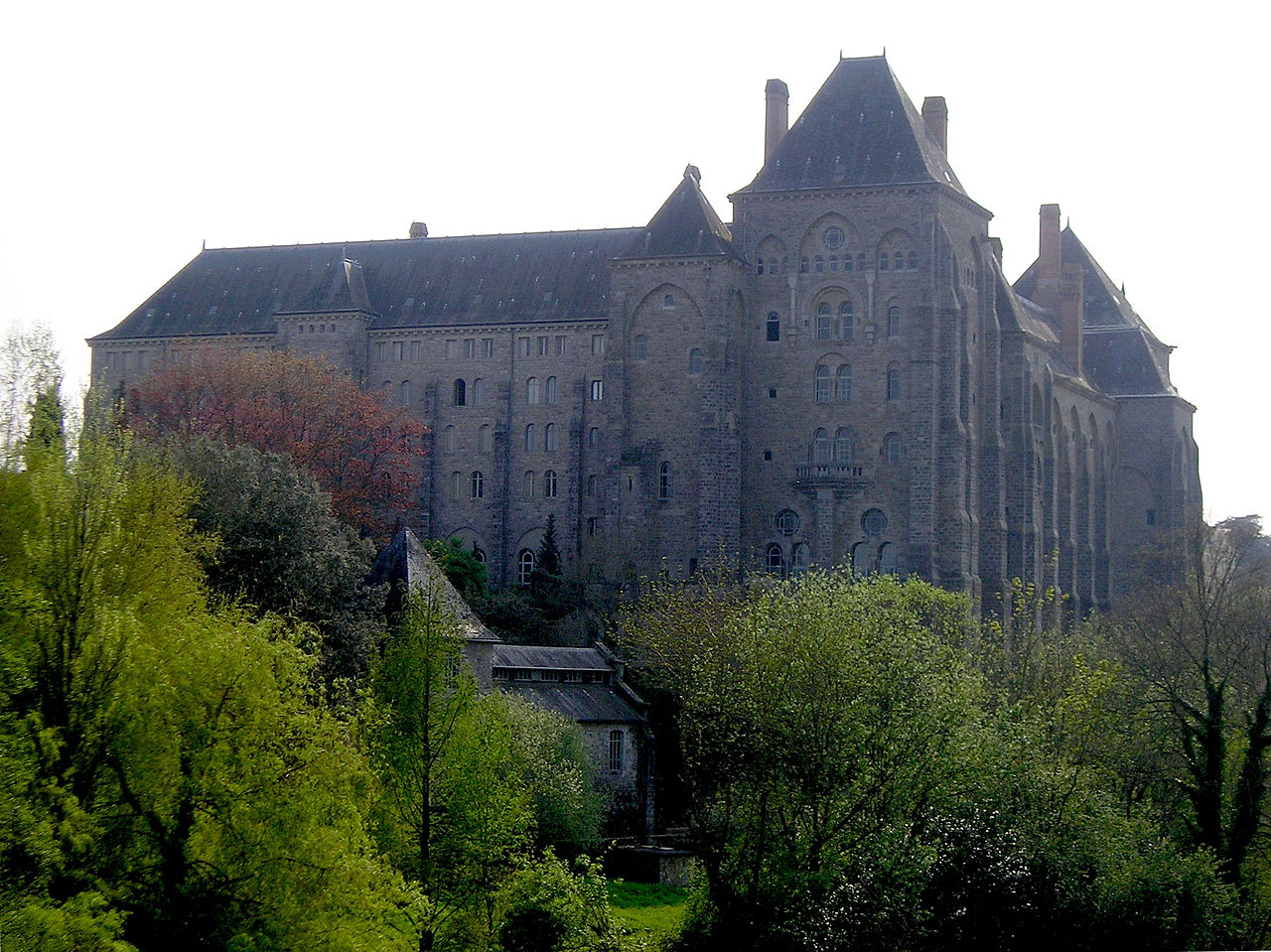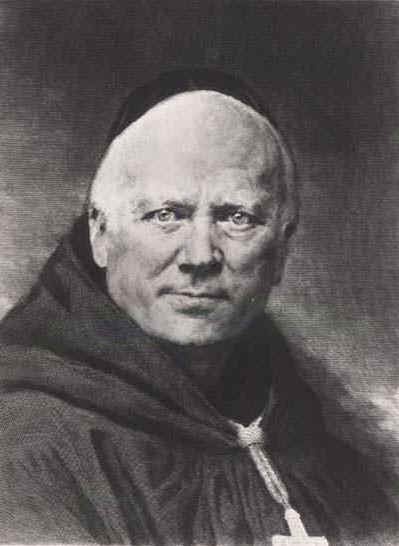English: Fleury Abbey,
Saint-Benoît-sur-Loire, Loiret, France.
Français: Eglise abbatiale Saint-Benoit.
Photo: 1893.
Source: Own work.
Photographer: Séraphin-Médéric Mieusement (1840–1905).
(Wikimedia Commons)
Text from Wikipedia - the free encyclopædia,
unless stated otherwise.
Fleury Abbey (Floriacum), Saint-Benoît-sur-Loire, Loiret, France, Founded about 640 A.D.,[1] is one of the most celebrated Benedictine Monasteries of Western Europe, and possesses the relics of Saint Benedict of Nursia.
Its site on the Banks of The River Loire has always made it easily accessible from Orléans, a centre of culture unbroken since Roman times.[2] Today, the Abbey has over forty Monks and is headed by the Abbot Etienne Ricaud.[3]
Abbo of Fleury (☩ 1004), a Monk and Abbot of Fleury, was a Theologian of wide-ranging intellect; his life was written by the chronicler, Aimoin, also a Monk of Fleury. Andrew of Fleury (writing circa 1043) wrote Miracula sancti Benedicti. Hugh of Fleury (☩ 1118) was a Monk of Fleury known for his chronicles and other writings.
The Nave, Fleury Abbey.
Photo: 22 January 2006.
Source: Own work.
Author: Nguyenld
(Wikimedia Commons)
The Church of Saint Peter was demolished in the 18th-Century; the existing Church, Dedicated to The Blessed Virgin Mary, pre-existed the Founding of the Monastery. After the ravages of The Normans, who penetrated via The River Loire and burned the Monastery buildings, which also suffered a catastrophic fire in 1026, this Church became the great Late-11th-Century Romanesque Basilica, which occasioned the erection of a great Tower, that was intended as The Great West Front of The Abbey Church, which was completed in 1218.
It was here that The Fleury Playbook was compiled, perhaps in Dedication to the new Church. The Tower of Abbot Gauzlin,[5] resting on fifty Columns, forms a unique Porch.
The Carolingian-Style Church is about three hundred feet long, its Transept is one hundred and forty feet wide. The Choir of the Church contains the tomb of a French Monarch, King Philip I of France, buried there in 1108. Of the Mediæval Abbey's buildings, only this Basilica survives in the modern Monastery.
The most famous of the Merovingian Abbots was Saint Mommolus, who effected the translation of the Relics of Saint Benedict of Nursia[6] to the Abbey. The Monastery underwent a season of reform in its Monastic life, about 930 A.D., along the lines first laid out at Cluny Abbey. The Monastery enjoyed the patronage of The Carolingian dynasty for generations; it was also central to the political ambitions of The Robertian House, descended from King Robert I of France, several of whom had held the Title of Duke of The Franks.
Theodulphus, Bishop of Orléans, established at Fleury a school for young noblemen, recommended there by Emperor Charlemagne. By the Mid-9th-Century A.D., its Library was one of the most comprehensive ever assembled in The West, and scholars such as Lupus of Ferrières (☩ 862 A.D.) travelled there to consult its Texts.
Later, under Saint Abbo of Fleury (Abbot 988 A.D. - 1004), Head of the reformed Abbey School, Fleury enjoyed a second golden age; it kept up close relations with Abbeys in England. Later, among the non-resident Abbots “in commendam”, were Cardinals Odet de Coligny and Antoine Sanguin, in the reign of King François I and Cardinal Richelieu.
Like all Benedictine Monasteries in France, the Community were scattered by The French Revolution. Nevertheless, a Benedictine presence remained continually: The Parish was held by a Monk disguised as a Secular Priest, and there were numerous attempts to restore the Monastery throughout the 19th-Century.[7]
Finally, in 1944, the Community (which had been resident at Pierre-qui-Vire) was restored to the Abbey, which was rebuilt as a member of The Subiaco Congregation.[8] The Monastery is remembered each day at Evensong in Winchester Cathedral, England, with an additional Prayer at the conclusion of The Responses – “The Fleury Prayer”.[9]
English: Coat-of-Arms, Fleury Abbey,
Saint-Benoît-sur-Loire, Loiret, France.
Français : Abbaye de Saint-Benoît-sur-Loire.
Italiano: Abbaye de Saint-Benoît-sur-Loire, Francia.
Source: Own work.
Author: Ssire
(Wikimedia Commons)
The 17th-Century Benedictine scholar, Jean Mabillon, accepted the Traditional Founding of Fleury Abbey as by Leodebaldus, Abbot of Saint-Aignan (Orléans) about 640 A.D., in the existing Gallo-Roman villa of Floriacum, in the Vallis Aurea, the "Golden Valley". This was the spot selected by the Abbot of Saint-Aignan for his Benedictine Foundation. Rigomarus was its first Abbot.
The most famous of the Merovingian Abbots was Saint Mommolus, who effected the translation of the Relics of Saint Benedict of Nursia[6] to the Abbey. The Monastery underwent a season of reform in its Monastic life, about 930 A.D., along the lines first laid out at Cluny Abbey. The Monastery enjoyed the patronage of The Carolingian dynasty for generations; it was also central to the political ambitions of The Robertian House, descended from King Robert I of France, several of whom had held the Title of Duke of The Franks.
The Monk of Fleury named Helgaud (☩ 1068), was Chaplain to King Robert II and wrote a brief “Epitoma vitæ Roberti regis”. Fleury Abbey had particular significance in lending legitimacy to its Patrons. Although Royal and Ducal Patronage had material advantages, there was also a price to be paid, in terms of Monastic autonomy, when the Ducal candidate conflicted with the choice of the Monastic community.
English: Fleury Abbey,
Saint-Benoît-sur-Loire, Loiret, France.
Français : Eglise abbatiale Saint-Benoit.
Photo: 1893.
Source: Own work.
Photographer: Séraphin-Médéric Mieusement (1840–1905).
(Wikimedia Commons)
Later, under Saint Abbo of Fleury (Abbot 988 A.D. - 1004), Head of the reformed Abbey School, Fleury enjoyed a second golden age; it kept up close relations with Abbeys in England. Later, among the non-resident Abbots “in commendam”, were Cardinals Odet de Coligny and Antoine Sanguin, in the reign of King François I and Cardinal Richelieu.
Like all Benedictine Monasteries in France, the Community were scattered by The French Revolution. Nevertheless, a Benedictine presence remained continually: The Parish was held by a Monk disguised as a Secular Priest, and there were numerous attempts to restore the Monastery throughout the 19th-Century.[7]
English: Fleury Abbey,
Saint-Benoît-sur-Loire, Loiret, France.
Français : Eglise abbatiale Saint-Benoit.
Photo: 30 October 2011.
Source: Own work.
Author: Gilbertus
(Wikimedia Commons)
Fleury Abbey is reputed to contain the Relics of Saint Benedict of Nursia, the Father of Western Monasticism. Saint Mommolus, the second Abbot of Fleury Abbey, is said to have effected their Transfer when that Abbey fell into decay after the ravages of The Lombards in the 7th-Century A.D. Benedict's Relics, and the “Miracula Sancte Benedicti”, developed over three Centuries by five Monks of Fleury, including Andreas of Fleury,[10] attracted Pilgrims, bringing wealth and fame.
Monks of the Italian Monastery, Monte Cassino, which was Founded by Benedict, himself, disputed this story. They claimed that Monte Cassino possesses the remains of the body of Saint Benedict, but have never shown Relics as proof.
Carolingian Architecture is the Style of North European Pre-Romanesque Architecture belonging to the period of The Carolingian Renaissance of the Late-8th-Century A.D. and the 9th-Century A.D., when The Carolingian dynasty dominated West European politics. It was a conscious attempt to emulate Roman Architecture and, to that end, it borrowed heavily from Early-Christian and Byzantine Architecture, though there are nonetheless innovations of its own, resulting in a unique character.
The Gatehouse of the Monastery at Lorsch, Germany, built around 800 A.D., exemplifies Classical inspiration for Carolingian Architecture, built as a Triple-Arched Hall dominating the Gateway, with the Arched Façade interspersed with attached Classical Columns and Pilasters, above.
The Palatine Chapel, in Aachen, Germany, constructed between 792 A.D. – 805 A.D., was inspired by the Octagonal Justinian Church of San Vitale, Ravenna, Italy, built in the 6th-Century A.D., but, at Aachen, there is a tall monumental Western entrance complex, called a Westwork — a Carolingian innovation.
Carolingian Churches, generally, are Basilican, like the Early-Christian Churches of Rome, and commonly incorporated Westworks, which is arguably the precedent for the Western facades of later Mediæval Cathedrals. An original Westwork survives today at the Abbey of Corvey, in Germany, built in 885 A.D.
Monks of the Italian Monastery, Monte Cassino, which was Founded by Benedict, himself, disputed this story. They claimed that Monte Cassino possesses the remains of the body of Saint Benedict, but have never shown Relics as proof.
Carolingian Architecture is the Style of North European Pre-Romanesque Architecture belonging to the period of The Carolingian Renaissance of the Late-8th-Century A.D. and the 9th-Century A.D., when The Carolingian dynasty dominated West European politics. It was a conscious attempt to emulate Roman Architecture and, to that end, it borrowed heavily from Early-Christian and Byzantine Architecture, though there are nonetheless innovations of its own, resulting in a unique character.
The Palatine Chapel, in Aachen, Germany, constructed between 792 A.D. – 805 A.D., was inspired by the Octagonal Justinian Church of San Vitale, Ravenna, Italy, built in the 6th-Century A.D., but, at Aachen, there is a tall monumental Western entrance complex, called a Westwork — a Carolingian innovation.
Carolingian Churches, generally, are Basilican, like the Early-Christian Churches of Rome, and commonly incorporated Westworks, which is arguably the precedent for the Western facades of later Mediæval Cathedrals. An original Westwork survives today at the Abbey of Corvey, in Germany, built in 885 A.D.
The Web-Site of Fleury Abbey can be found HERE























